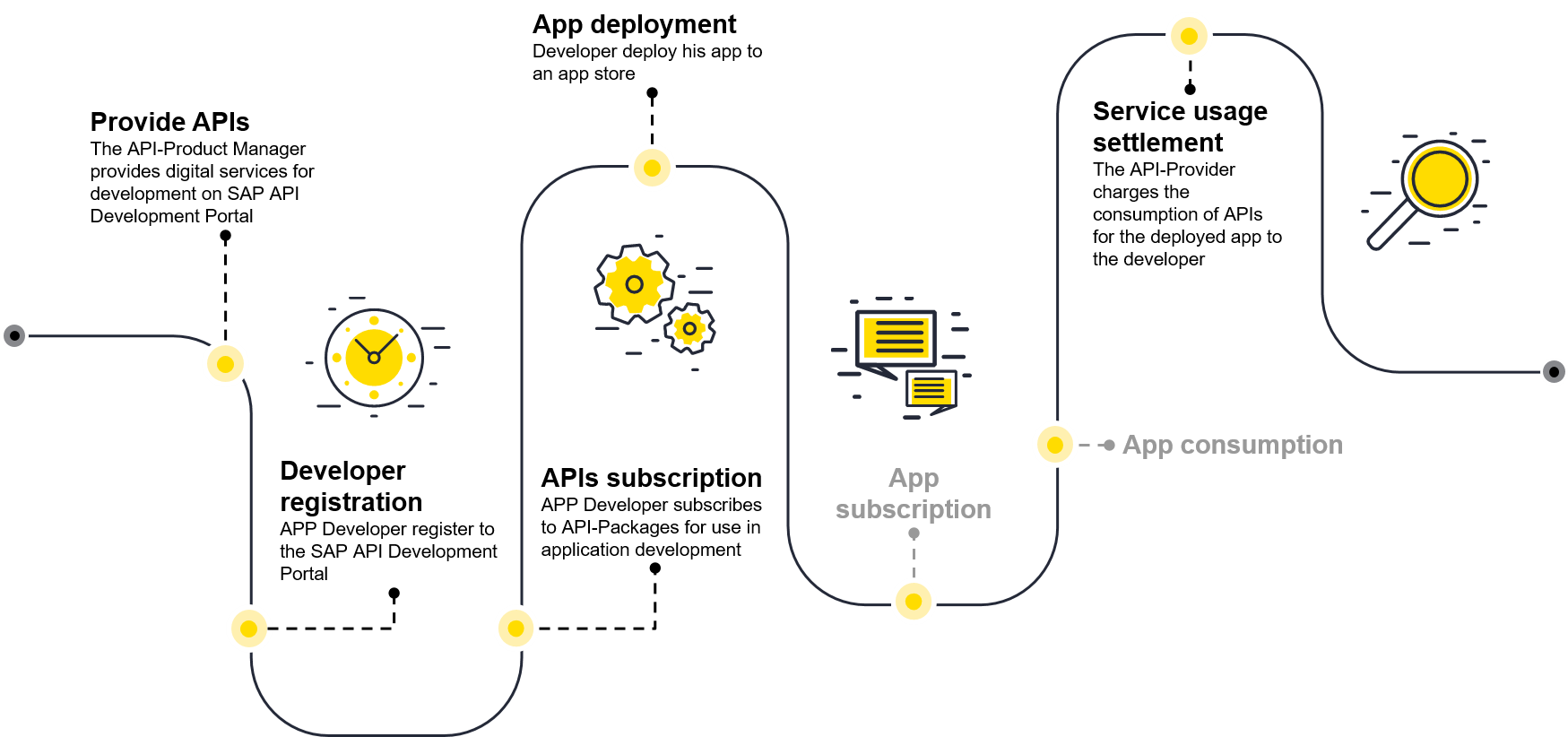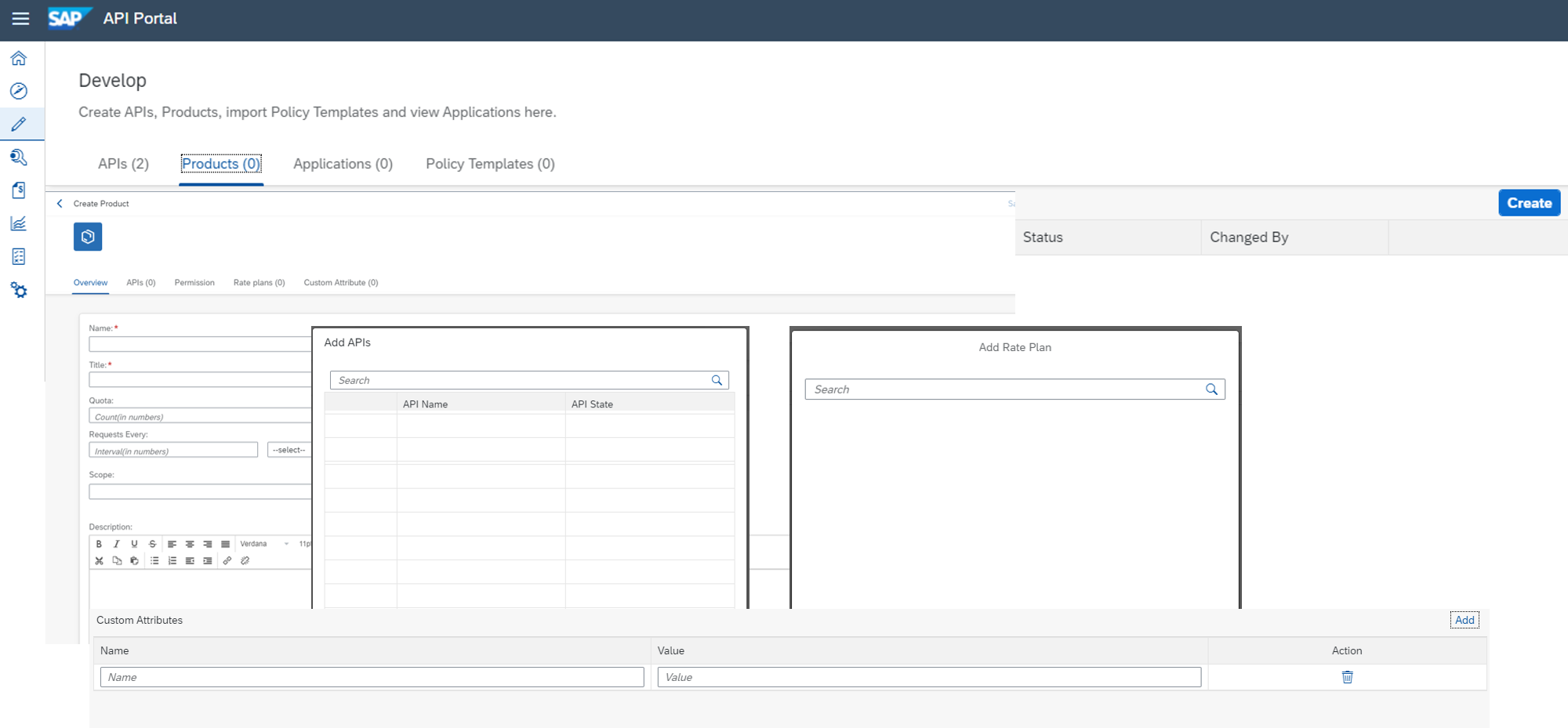
- SAP Community
- Products and Technology
- Technology
- Technology Blogs by SAP
- Use-Case: Monetization of digital services Part 1
Technology Blogs by SAP
Learn how to extend and personalize SAP applications. Follow the SAP technology blog for insights into SAP BTP, ABAP, SAP Analytics Cloud, SAP HANA, and more.
Turn on suggestions
Auto-suggest helps you quickly narrow down your search results by suggesting possible matches as you type.
Showing results for
Advisor
Options
- Subscribe to RSS Feed
- Mark as New
- Mark as Read
- Bookmark
- Subscribe
- Printer Friendly Page
- Report Inappropriate Content
11-09-2020
12:01 PM
In this blog post i explain to you business models for monetization of digital services and how the necessary capabilities can be implemented on cloud-based solutions from the SAP Portfolio.
Introduction
The API-Provider offers several APIs to registered developers so that can build apps using this services. The deployed app can be offered in an app store. User can subscribe to this app from an app store and consume this app from their devices. The user will be charged by the app store and at least the infrastructure provider will charge the API consumption to these developers who has subscribed to such APIs.

Figure: Parties and actors
Monetization of Infrastructure APIs
Overview
This business-case focus on the API-Provider, that means publishing APIs on an Developer portal, subscription of API-Packages by developer and charging the service consumption to the developer.

Figure: Involved parties and actors
From a functional perspective the following capabilities are relevant:
- Publishing APIs to developers by infrastructure provider
- Build application by developer using subscribed APIs
- Application consumption by user(s)
- Metering of application usage
- Providing billing information to developer
The following figure illustrates the process flow our business model.

Figure: Process flow
SAP Solution Architecture
The main business solutions are:
- SAP API Management for administration of digital services
- SAP Subscription Billing for subscription management and billing
- SAP S/4HANA Cloud for invoicing and accounts receivable management

Figure: Technical Solution Architecture
I recommend the use of SAP Cloud Platform Integration Suite for the process integration between these business applications The following figure illustrates the actors, information objects, relationships and data flows from a technical perspective.
Implementation Plan
In this chapter i give you an overview of the building blocks and implementation steps.
Building Blocks
SAP API Management
This building block contains API Management which is the process of publishing, promoting and overseeing APIs is a secure and scalable manner. SAP API Management provides secure governance over APIs based on open standards like SOAP, REST, OData, with enterprise grade security. This simplifies the way developers go about integrating with their SAP and non-SAP application, reducing cost, foster innovation and participate in the larger API economy.
https://help.sap.com/viewer/product/SAP_CLOUD_PLATFORM_API_MANAGEMENT/Cloud/en-US
SAP Subscription Billing
This building block contains Subscription Management capabilities to manage subscription products, bundles and rate plans. An Subscription lifecycle management with an automated order fulfillment processes across multiple systems. It provides a simplified, automated approach for billing and ordering processes to monetize new offers quickly and effectively.
https://help.sap.com/viewer/product/CLOUD_TO_CASH_OD/2020-09-30/en-US
SAP S/4HANA Cloud
SAP S/4HANA is a future-ready enterprise resource planning (ERP) system with built-in intelligent technologies, including AI, machine learning, and advanced analytics. It transforms business processes with intelligent automation and runs on SAP HANA – a market-leading in-memory database that offers real-time processing speeds and a dramatically simplified data model.
https://help.sap.com/viewer/product/SAP_S4HANA_CLOUD/2008.500/en-US?task=discover_task
Implementation Steps
The following chapter explains the business objects and integrations topics for each process step.
Provide APIs
In this building block you act as the API-Provider, so you have to perform the following steps in API Portal of SAP API Management:
The starting point is to create an API-Proxy, a representation of an existing API, and deploy it.

Figure: Create API
Next step to process is to create a Rate Plan.

Figure: Create Rate Plan
Now you are able to create the product which includes the APIs, an Rate Plan and some additional custom attributes. This custom attributes are very helpful when it comes to an integration with SAP Subscription Billing later on. I can recommend to use the following attributes, such as market, metric and Technical Ressource ID.

Figure: Create Product
When you have saved, don't forget to publish your product.
Developer registration, APIs subscription and App development
In this building block you act as the Developer, so you have to perform the following steps
in API Developer Portal of SAP API Management.
If you are registered as an Developer you can access the Developer Portal to start working.
When you are logged into the API Developer Portal you can subscribe to the published product(s) and starting to create an application. When you finished application development you only need to deploy your Application.

Figure: API Developer Portal
In the following blog post i explain how to use APIs for integration of SAP Subscription Billing with SAP API Management to generate the necessary business objects in SAP Subscription Billing and at least how Service usage settlement could be done.
Thanks for joining this blog post.
This blog post is part of a blog post series. Please find the other blog post(s) here:
Use-Case: Monetization of digital services Part 2
Subscription Management – A Blog Series
- SAP Managed Tags:
- SAP Integration Suite,
- API Management,
- SAP Subscription Billing,
- SAP S/4HANA Public Cloud
Labels:
2 Comments
You must be a registered user to add a comment. If you've already registered, sign in. Otherwise, register and sign in.
Labels in this area
-
ABAP CDS Views - CDC (Change Data Capture)
2 -
AI
1 -
Analyze Workload Data
1 -
BTP
1 -
Business and IT Integration
2 -
Business application stu
1 -
Business Technology Platform
1 -
Business Trends
1,661 -
Business Trends
88 -
CAP
1 -
cf
1 -
Cloud Foundry
1 -
Confluent
1 -
Customer COE Basics and Fundamentals
1 -
Customer COE Latest and Greatest
3 -
Customer Data Browser app
1 -
Data Analysis Tool
1 -
data migration
1 -
data transfer
1 -
Datasphere
2 -
Event Information
1,400 -
Event Information
65 -
Expert
1 -
Expert Insights
178 -
Expert Insights
280 -
General
1 -
Google cloud
1 -
Google Next'24
1 -
Kafka
1 -
Life at SAP
784 -
Life at SAP
11 -
Migrate your Data App
1 -
MTA
1 -
Network Performance Analysis
1 -
NodeJS
1 -
PDF
1 -
POC
1 -
Product Updates
4,577 -
Product Updates
330 -
Replication Flow
1 -
RisewithSAP
1 -
SAP BTP
1 -
SAP BTP Cloud Foundry
1 -
SAP Cloud ALM
1 -
SAP Cloud Application Programming Model
1 -
SAP Datasphere
2 -
SAP S4HANA Cloud
1 -
SAP S4HANA Migration Cockpit
1 -
Technology Updates
6,886 -
Technology Updates
408 -
Workload Fluctuations
1
Related Content
- SAP Partners unleash Business AI potential at global Hack2Build in Technology Blogs by SAP
- 10+ ways to reshape your SAP landscape with SAP Business Technology Platform - Blog 7 in Technology Blogs by SAP
- Value Unlocked! How customers benefit from SAP HANA Cloud in Technology Blogs by SAP
- Partner-2-Partner Collaboration in Manufacturing in Technology Blogs by SAP
- Enter the era of spatial computing for enterprise with SAP Build Code in Technology Blogs by SAP
Top kudoed authors
| User | Count |
|---|---|
| 13 | |
| 10 | |
| 10 | |
| 9 | |
| 7 | |
| 6 | |
| 5 | |
| 5 | |
| 5 | |
| 4 |